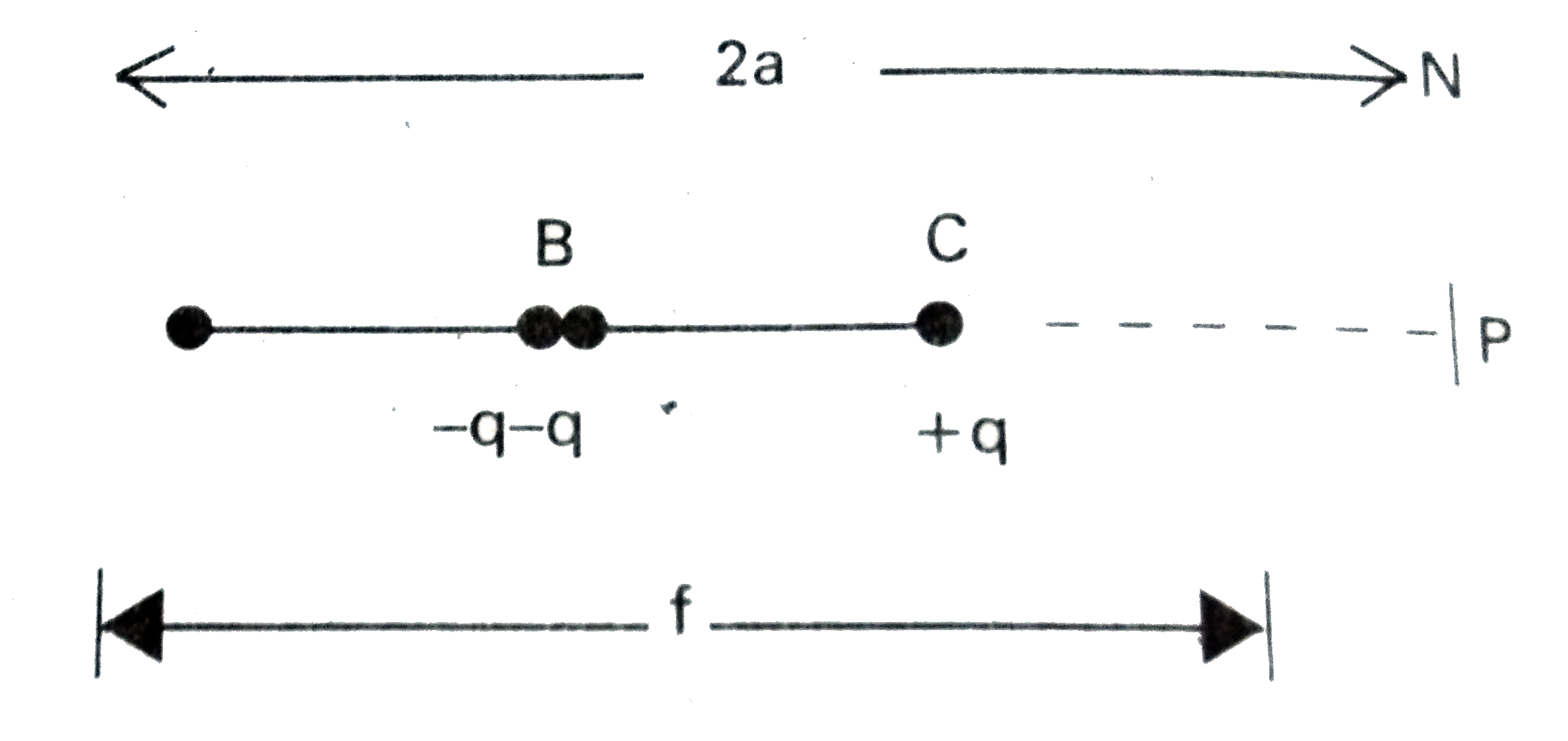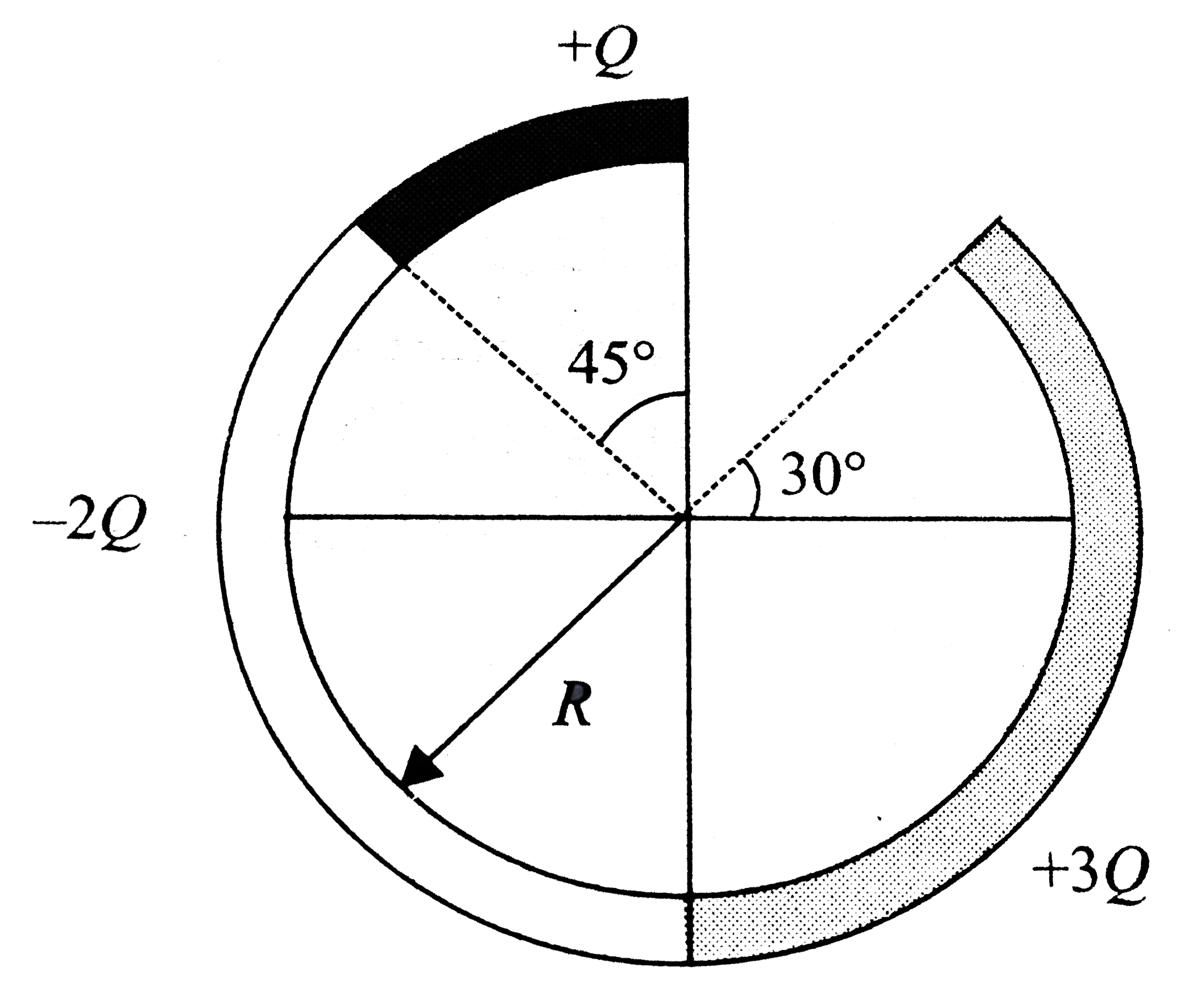Figure shows a charge array known as an electric qudarupole. For a point on the axis of the quadrupole , obtain the dependence of potential on r for r/a>>1. And contrast your results with that due to an electric dipole, and an electric monopole (i.e., a single charge).

As is clear from figure an electric quadrupole may be ragarded as a system of three charges +q, - 2q and + q at A,B and C respectively.
Let AC = 2a we have to calculate electric potential at any point P where BP = r, using superposition principle. Potential at p is given by
V=14πε0[qr+a−2qr+qr−a]
=q4πε0[r(r−a)−2(r+a)(r−a)+r(r+a)r(r2+a2)]
=q(r2−ra−2r2+r2+ra)4πε0r(r2−a2)
V=q.2a24πε0r(r2−a2)

V=q.2a24πε0r3(1−a2/r2)
ra>>1,r>>a or a<<r
∴a2r2 is negligibly small V=q.2a24πε0r3
clearly V∝1r3
In case of an electric dipole v∝1r2 and in case of an electric monopole
(i.e., a single charge), V∝1r
Topper's Solved these Questions
- BOOK - VIKRAM PUBLICATION ( ANDHRA PUBLICATION)CHAPTER - ELECTROSTATIC POTENTIAL AND CAPACITANCEEXERCISE - Textual Examples10videos
ELECTROSTATIC POTENTIAL AND CAPACITANCE
- BOOK - VIKRAM PUBLICATION ( ANDHRA PUBLICATION)CHAPTER - ELECTROSTATIC POTENTIAL AND CAPACITANCEEXERCISE - Important Questions3videos
ELECTROSTATIC POTENTIAL AND CAPACITANCE
- BOOK - VIKRAM PUBLICATION ( ANDHRA PUBLICATION)CHAPTER - ELECTROSTATIC POTENTIAL AND CAPACITANCEEXERCISE - Textual Exercises11videos
ELECTROSTATIC POTENTIAL AND CAPACITANCE
- BOOK - VIKRAM PUBLICATION ( ANDHRA PUBLICATION)CHAPTER - ELECTROMAGNETIC WAVEEXERCISE - ADDITIONAL EXERCISES19videos
ELECTROMAGNETIC WAVE
- BOOK - VIKRAM PUBLICATION ( ANDHRA PUBLICATION)CHAPTER - MAGNETISM AND MATTEREXERCISE - Additional Exercises19videos
MAGNETISM AND MATTER
Similar Questions
Fig shows a charge array known as an 'electric quadrupole'. For a point on the axis of the quadrupole, obtain the dependence of potential on r for r/a>>1, and contract your results with that due to an electric dipole and an electric monopole (i.e, a single charge).
 View Solution
View SolutionFig shows a charge array known as an 'electric quadrupole'. For a point on the axis of the quadrupole, obtain the dependence of potential on r for r/a>>1, and contract your results with that due to an electric dipole and an electric monopole (i.e, a single charge).
 View Solution
View Solution
Knowledge Check
- Question 1 - Select One
The electric potential at a point on the axis of an electric dipole depends on the distance r of the point from the dipole as
A∝1rB∝1r2C∝rD∝1r3 - Question 2 - Select One
The electric potential V at a point on the axis of an electric dipole depends on the distance 'r of the point from the dipole as
AV∝1rBV∝1r2CV∝1r3DV∝r - Question 3 - Select One
(Figure 3.139) shows three circular arcs, each of radius R and total charge as indicated. The net electric potential at the center of curvature.
 .AQ2πε0RB5Q12πε0RC3Q32πε0RDnone of these
.AQ2πε0RB5Q12πε0RC3Q32πε0RDnone of these
The figure given below shows a charge array known as an 'electric quadrupole'. For a point on the axis of the quadrupole, obtain the dependence of potential on r for ra>>1. Contrast your result with that due to an electric dipole and an electric monopole (i.e. a single charge).
 View Solution
View SolutionFigure shows a charge array known as an "electric quadrupole". For a point on the axis of the quadruple, the dependence of potential on r(ra>>1) is 1rn. Find n?
 View Solution
View SolutionFigure shows a charge array known as an "electric quadrupole". For a point on the axis of the quadruple, the dependence of potential on r(ra>>1) is 1rn. Find n?
 View Solution
View SolutionDeduce an expression for the electric potential due to an electric dipole at any point on its axis. Mention one contrasting feature of electric potential of a dipole at a point as compared to that due to a single charge.
View SolutionDeduce an expression for the electric potential due to an electric dipole at any point on its axis. Mention one contrasting feature of electric potential at a point due to dipole as compared to that due to a single charge.
View Solution

